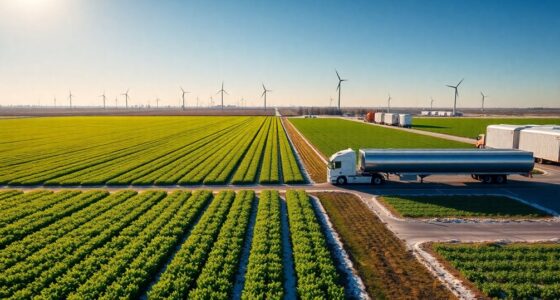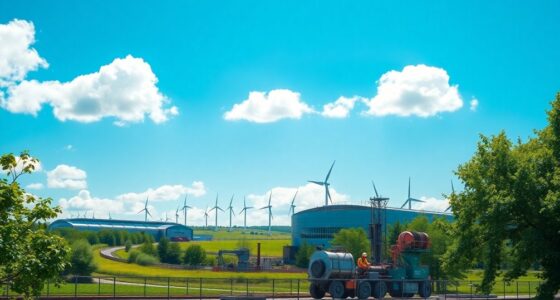3D printing transforms sustainable manufacturing by minimizing waste and boosting energy efficiency. It allows you to create complex designs using only the necessary materials, cutting down on excess scraps typical of traditional methods. Plus, many 3D printing materials can be recycled or are biodegradable, further reducing environmental impact. This innovative approach not only meets individual needs with on-demand production but also promotes eco-friendly practices. Want to uncover more about the future of this technology?
Key Takeaways
- 3D printing minimizes waste by using only necessary materials, unlike traditional manufacturing which often produces significant scrap.
- The technology allows for on-demand production, reducing excess inventory and overproduction, aligning with sustainable practices.
- Many 3D printing materials are recyclable, contributing to lower environmental impact and promoting a circular economy.
- Energy consumption is typically lower in 3D printing compared to conventional manufacturing, leading to reduced operational costs and carbon footprints.
- Future trends in 3D printing focus on biodegradable materials and advanced recycling methods, enhancing sustainability in manufacturing processes.
The Basics of 3D Printing Technology

While you might be familiar with traditional manufacturing methods, 3D printing technology offers a radically different approach. Instead of using subtractive techniques, where material is cut away, 3D printing builds objects layer by layer.
3D printing revolutionizes manufacturing by building objects layer by layer, allowing for intricate designs and rapid prototyping.
This additive process allows you to create complex shapes and designs that would be difficult or impossible to achieve otherwise. You can use various materials, including plastics, metals, and even ceramics, which gives you a lot of flexibility.
The technology also enables rapid prototyping, so you can test and refine your designs quickly. As a result, you save time and resources, making it an efficient option for both small-scale projects and large-scale production.
Embracing 3D printing could significantly change how you think about manufacturing.
Environmental Impact of Traditional Manufacturing
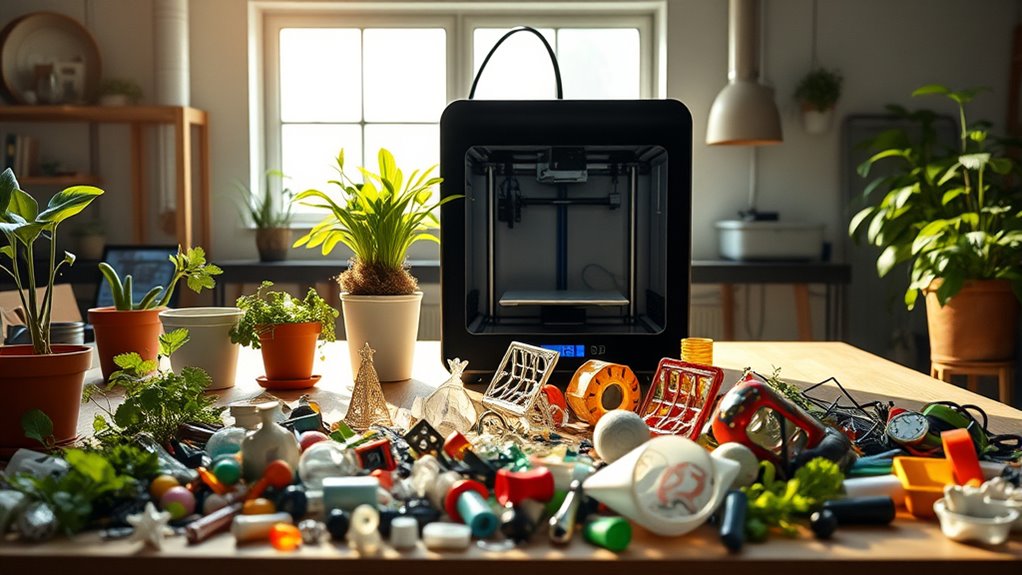
Traditional manufacturing significantly contributes to environmental degradation, as it often involves processes that consume vast amounts of energy and generate substantial waste.
You mightn't realize it, but factories release harmful emissions, polluting air and water sources. The extraction of raw materials, essential for production, depletes natural resources and disrupts ecosystems.
Additionally, traditional manufacturing relies heavily on non-renewable resources, leading to further environmental strain. You can see the consequences in landfills overflowing with discarded products and packaging.
This inefficient cycle of production and disposal not only harms the planet but also impacts human health. By understanding these issues, you can appreciate the need for innovative solutions that prioritize sustainability and reduce the environmental footprint of manufacturing processes.
How 3D Printing Reduces Material Waste
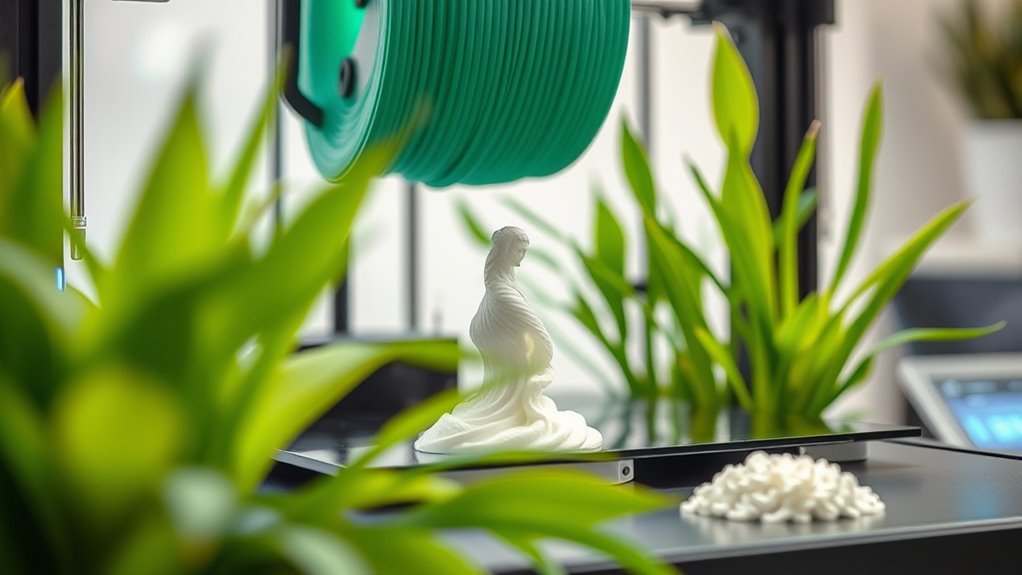
The shift towards 3D printing presents a compelling solution to the material waste generated by conventional manufacturing methods.
The transition to 3D printing offers an innovative way to reduce material waste in manufacturing.
With traditional techniques, cutting, drilling, and milling often leave behind significant scrap materials. In contrast, 3D printing builds objects layer by layer, using only the necessary amount of material for each part. This additive process minimizes excess waste, allowing you to maximize resources effectively.
Plus, many 3D printing materials are recyclable, further reducing your environmental footprint. By customizing designs to meet specific needs, you can also avoid overproduction, ensuring that each item produced serves a clear purpose.
Embracing 3D printing not only conserves materials but also aligns your manufacturing practices with sustainable principles, paving the way for a greener future.
Energy Efficiency in 3D Printing Processes

As you explore energy efficiency in 3D printing processes, you'll discover that this innovative manufacturing method can significantly reduce energy consumption compared to conventional techniques.
Traditional manufacturing often involves multiple steps and machinery, each consuming energy. In contrast, 3D printing typically requires less energy since it builds objects layer by layer, directly from a digital model. This streamlined approach minimizes energy waste, especially when producing complex designs.
Moreover, many 3D printers use advanced technologies that optimize power usage, like automatic shut-off features and energy-efficient components. By adopting 3D printing in your manufacturing practices, you're not just saving energy; you're also contributing to a more sustainable future.
Embracing these energy-efficient processes can lead to lower operational costs and a reduced carbon footprint.
Biodegradable and Recycled Materials in 3D Printing
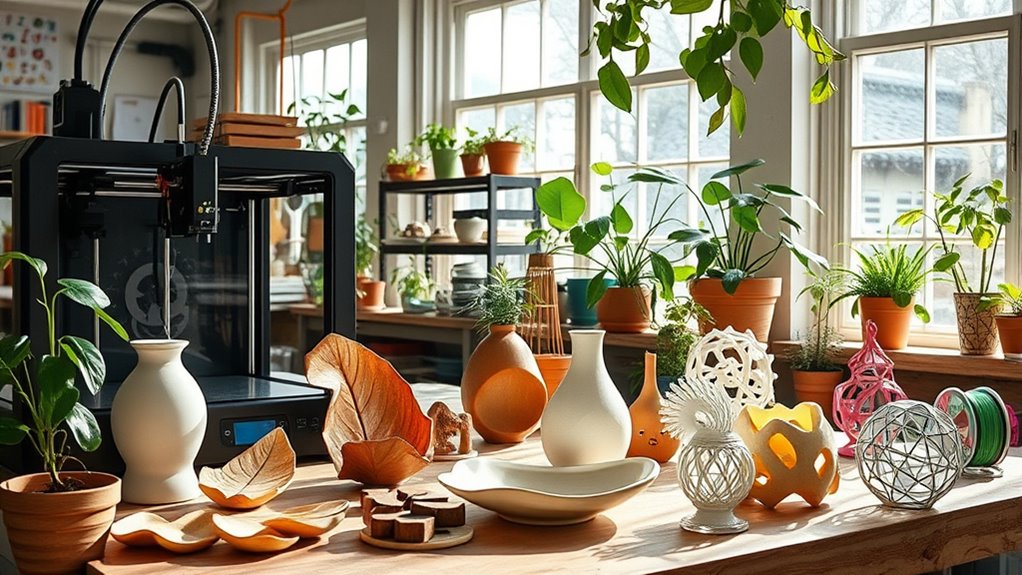
3D printing not only enhances energy efficiency but also opens up opportunities for using biodegradable and recycled materials.
By choosing materials like PLA (polylactic acid), derived from corn starch, you're supporting a more sustainable approach. These materials break down naturally, reducing landfill waste and pollution.
Choosing PLA, a biodegradable material from corn starch, supports sustainability by naturally breaking down and minimizing landfill waste.
You can also utilize recycled filaments made from post-consumer plastics, turning waste into functional products. This shift not only lowers the environmental impact but also encourages innovation in material development.
As a maker or designer, exploring these options allows you to create eco-friendly solutions that align with your values.
Embracing biodegradable and recycled materials in your 3D printing projects means you're contributing to a more sustainable future while maintaining quality and functionality.
Customization and On-Demand Production
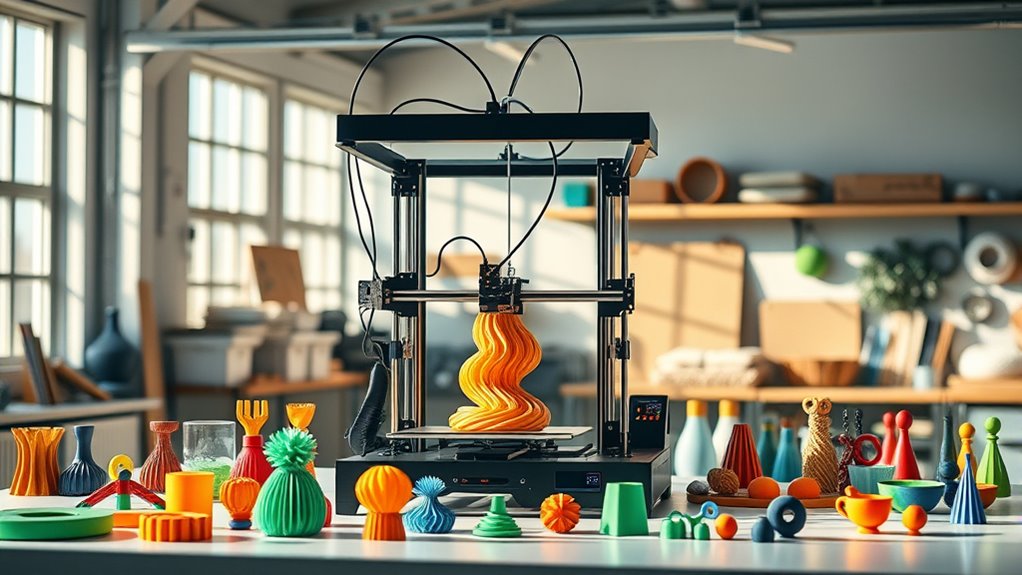
While traditional manufacturing often involves large-scale production runs, customization and on-demand production through 3D printing empowers you to create unique items tailored to individual needs.
You can design products that fit specific preferences, whether it's a personalized phone case or a custom prosthetic limb. This flexibility reduces waste, as you only produce what's necessary.
You don't have to worry about excess inventory or overproduction, which is a common issue in conventional manufacturing. Plus, you can quickly iterate on designs, making adjustments based on feedback or changing requirements.
This approach not only enhances consumer satisfaction but also aligns with sustainable practices by minimizing resource use. In short, 3D printing offers a more efficient path to meeting diverse demands.
Case Studies: Companies Leading in Sustainable 3D Printing
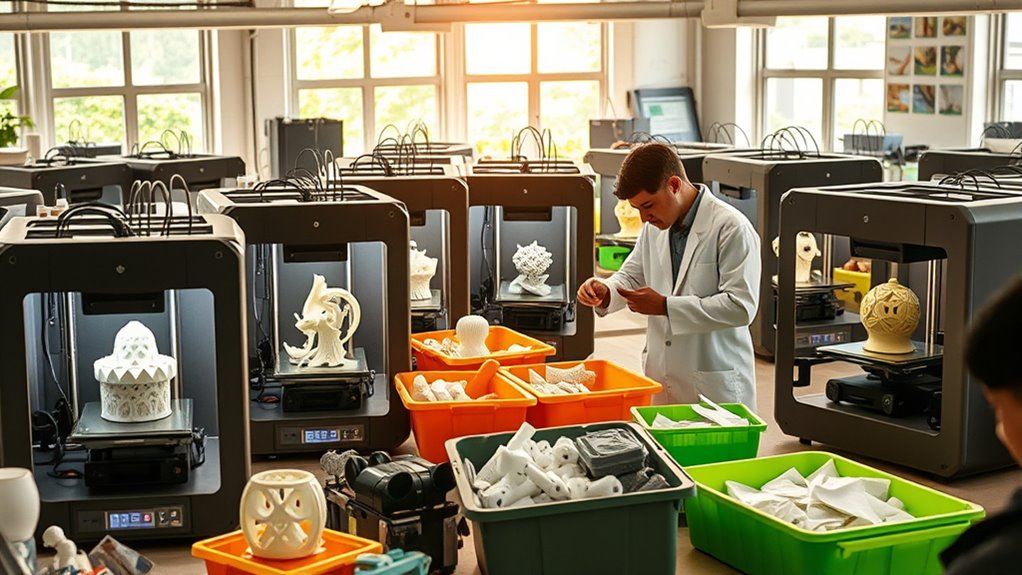
Numerous companies are harnessing the power of 3D printing to drive sustainability in manufacturing.
For instance, Adidas is using 3D printing to create shoes with reduced waste, allowing for on-demand production. By tailoring the design process, they minimize excess materials and energy consumption.
Similarly, local motors has developed a process for producing eco-friendly vehicles using 3D printing, significantly cutting down on traditional manufacturing's carbon footprint.
Local Motors is revolutionizing eco-friendly vehicle production with 3D printing, greatly reducing the carbon footprint of traditional manufacturing.
Another notable example is Boeing, which employs 3D printing for lightweight components in aircraft, leading to improved fuel efficiency.
These companies demonstrate how innovative approaches can reshape industries, demonstrating that sustainability and advanced manufacturing can go hand in hand.
Challenges and Limitations of 3D Printing for Sustainability
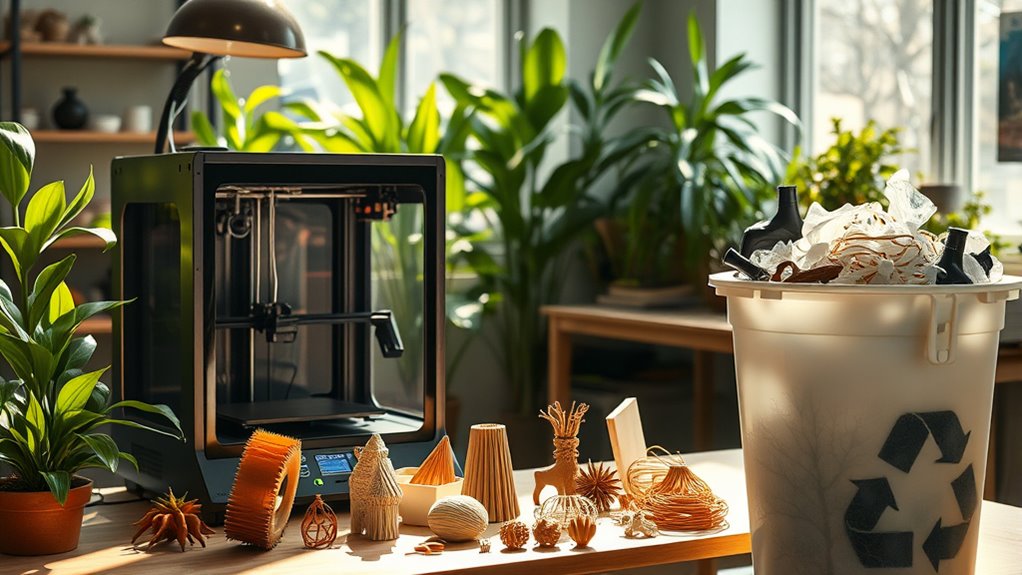
Although 3D printing offers exciting possibilities for sustainable manufacturing, several challenges and limitations can hinder its widespread adoption.
First, material waste during the printing process can still occur, impacting the sustainability goal. You might find that not all 3D printing materials are eco-friendly, often relying on plastics that aren't biodegradable.
Additionally, the energy consumption of high-quality printers can be significant, offsetting some environmental benefits.
There's also a steep learning curve and high initial costs, which can deter smaller businesses from adopting the technology.
Lastly, regulatory hurdles and inconsistent standards complicate the landscape, making it difficult to ensure that 3D-printed products are safe and sustainable.
Future Trends in 3D Printing and Eco-Friendly Practices
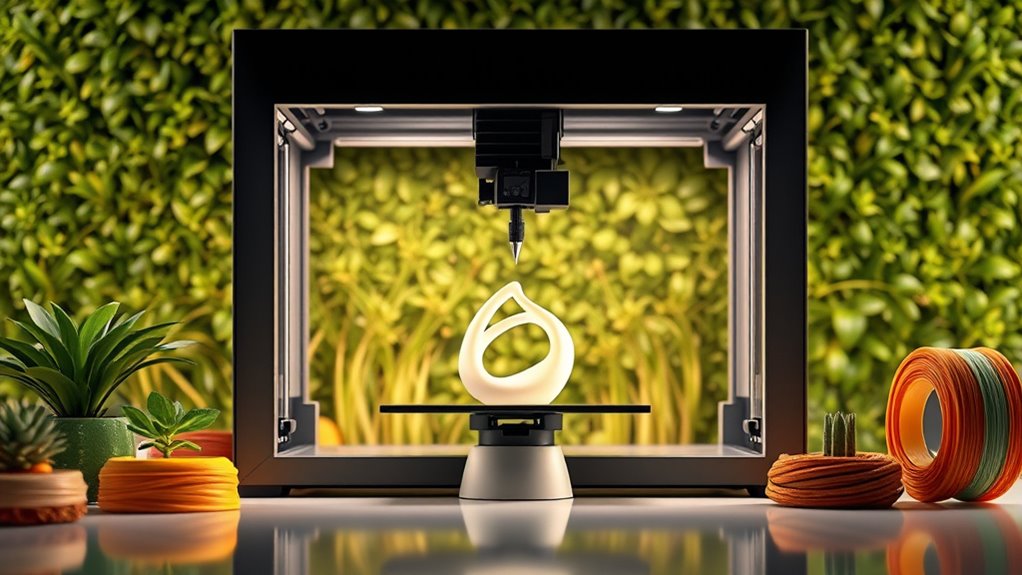
As the demand for sustainable practices grows, 3D printing is poised to evolve with innovative solutions that enhance eco-friendliness.
You'll likely see an increase in biodegradable materials, allowing you to create products that break down naturally rather than polluting the environment. Advanced recycling methods will also become commonplace, enabling you to use recycled materials without sacrificing quality.
Moreover, energy-efficient printing technologies will reduce energy consumption, making your production processes greener. You'll find that digital fabrication methods can minimize waste by producing only what you need.
Energy-efficient printing technologies and digital fabrication methods will significantly reduce waste and energy consumption in your production processes.
As more companies embrace these trends, you'll play a vital role in shaping a sustainable future through responsible manufacturing practices. The possibilities are exciting, and your choices can lead to significant environmental benefits.
The Role of Policy and Regulation in Sustainable Manufacturing

While the push for sustainable manufacturing gains momentum, policy and regulation play a crucial role in guiding practices that promote eco-friendliness. You can influence change by advocating for policies that prioritize sustainability, such as incentives for using renewable materials and penalties for excessive waste.
Regulations can also ensure that companies adhere to environmental standards, pushing them to innovate and adopt greener technologies.
As you engage with policymakers, emphasize the importance of collaboration between industries and government. This partnership can lead to more effective solutions that balance economic growth with environmental responsibility.
Ultimately, your active involvement in shaping these policies can help create a manufacturing landscape that values sustainability, benefiting both the planet and future generations.
Frequently Asked Questions
How Does 3D Printing Affect Job Opportunities in Manufacturing Sectors?
3D printing's impact on job opportunities in manufacturing is significant.
You'll find that it creates new roles focused on design, programming, and maintenance of printers. However, it can also lead to job displacement in traditional manufacturing roles as automation increases.
As industries adapt, you might need to upgrade your skills to stay relevant. Embracing these changes can open doors to innovative career paths, offering exciting challenges and growth opportunities.
What Are the Cost Implications of Transitioning to 3D Printing?
Transitioning to 3D printing involves several cost implications you need to consider.
Initially, you'll invest in new equipment and software, which can be significant. However, you might save on materials and waste reduction in the long run.
Training staff can add to costs, but it's essential for maximizing the technology's potential.
Ultimately, the shift could lead to lower production costs, depending on your specific needs and scale of operations.
Can 3D Printing Technology Be Used for Large-Scale Production?
When it comes to large-scale production, you might think it's a tall order, but 3D printing can definitely rise to the occasion.
It's versatile and can streamline manufacturing processes, making it feasible for mass production. By using multiple printers or larger machines, you can produce items faster and more efficiently.
However, keep in mind that scalability can depend on the type of products you're creating and the materials you're using.
What Industries Can Benefit Most From Sustainable 3D Printing?
You'll find that industries like fashion, automotive, and healthcare can benefit immensely from sustainable practices.
In fashion, you can create eco-friendly prototypes with minimal waste.
The automotive sector can produce lightweight parts that enhance fuel efficiency, while healthcare can utilize sustainable materials for custom prosthetics and implants.
Each of these industries not only reduces their environmental impact but also innovates their processes, leading to a more sustainable future overall.
How Do Consumers Perceive Eco-Friendly 3D Printed Products?
Consumers often view eco-friendly products as a positive choice, reflecting their values and commitment to the environment.
When you see 3D printed items made from sustainable materials, you might appreciate their reduced impact on the planet.
You're likely to feel that these products align with your lifestyle, promoting innovation while supporting sustainability.
This perception can influence your purchasing decisions, making you more inclined to choose eco-friendly options over traditional ones.
Conclusion
In the journey toward sustainable manufacturing, 3D printing serves as a beacon of hope, illuminating a path to reduced waste and energy use. By embracing this innovative technology, you can help transform industries and create a greener future. However, it's essential to navigate the challenges and stay informed about evolving practices. With commitment and creativity, you can be part of the revolution that reshapes how we produce and consume, turning the tide toward a more sustainable world.


